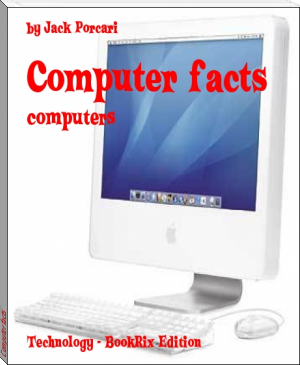The History of Apple Inc. by by : Malak Mansour (best novels to read for beginners TXT) 📖

- Author: by : Malak Mansour
Book online «The History of Apple Inc. by by : Malak Mansour (best novels to read for beginners TXT) 📖». Author by : Malak Mansour
1997-2000
Jobs' presence was known almost as quickly as NeXT was acquired. The degree of Jobs' "expanded role" soon became quite clear. With no CEO and Apple Stock lower than it had been in 5 years, there were many decisions to be made, and not much time to make them. Jobs began to make striking changes in the structure of Apple, including the canceling of the Newton spin-off. (The Newton was discontinued several months later.) The time and place for the most ground breaking announcements, however, would be MacWorld Boston in August 1997.
Jobs, who by now was being referred to as "interim CEO," made the keynote speech, and spoke of the company's upcoming aggressive advertising campaign, upcoming new Macs, and Rhapsody. He also announced an almost entirely new Board of Directors, including Larry Ellison, CEO of Oracle. But he saved the best for last. In a ground breaking decision, Jobs announced an alliance with Microsoft. In exchange for $150 million in Apple Stock, Microsoft and Apple would have a 5-year patent cross-license and, more importantly, a final settlement in the ongoing GUI argument. Microsoft agreed to pay an unreleased sum of additional funds to quiet the allegations that it had stolen Apple's intellectual property in designing its Windows OS. Microsoft also announced that Office '98, its popular office package, would be available for the Mac by years end.
These announcements gave Apple new life, but Jobs was not finished. There was one more big obstacle to tackle: Clones. Jobs felt that Clone Vendors such as Power Computing were cutting into Apple's high-end market, where they traditionally made the most profit. Clones had failed to effectively expand the MacOS market, instead taking customers away from Apple. Jobs remedied this apparent failure of the Clone experiment by all but pulling its plug. In early Fall 1997, Apple announced its intention to buy out Power Computing's MacOS license, and much of its engineering staff. Power went out of business several months later, with Apple taking over its product support. Apple also bought out its MacOS licences from Motorola and IBM. Umax was allowed to stay in the game, but with the tacit understanding that it would fill the low-end market, with machines selling for under $1000. Umax sold its remaining inventory of Macs, and is now selling "Wintel" boxes.
On November 10, 1997, Apple held another press conference, in which Jobs announced further changes to Apple's corporate strategy. Apple would now sell computers direct, both over the web and the phone, as Power Computing had done so well in the past. Jobs also announced two new Apple machines: the PowerMac G3, and the PowerBook G3.
The Apple Store was a runaway success, and within a week was the third-largest eCommerce site on the web. At MacWorld San Francisco in January, Jobs announced that Apple had, for the first time in more than a year, had a profitable First Quarter--to the tune of $44 Million. This far eclipsed analysts' projections, and sent Apple's stock back into the 20s. In April 1998, Jobs announced another profitable quarter ($57 Million), which came as a big surprise to nearly everyone. Jobs kept momentum moving, and in early May announced a newPowerBook G3, an Educational Apple Store, and an entirely new Mac design--the iMac. The iMac would be Apple's answer to the low-end consumer question, with more than enough computing power for most people, at an affordable price. Later that month, in his keynote at the WWDC, Jobs announced a dramatic shift in Apple's OS direction. Mac OS X would merge OS 8 and Rhapsody--Apple's upcoming version of NeXTStep--into one robust OS, with all the features of a modern OS and backward compatibility with most OS 8 applications.
In July 1998, Jobs announced that Apple had profited for the 3rd consecutive quarter--to the tune of $101 million. This helped to push Apple's stock to several 52-week highs in just a few days. The iMac was the best-selling computer in the nation for most of the fall, and it drove Apple sales well beyond most predictions. In the fall, Jobs announced another profitable quarter, making a full year of profitability. In January 1999, Jobs announced a 5th consecutive profitable quarter, with year-over-year growth, and a sleek new PowerMac G3.
n July 1999, Steve Jobs filled the final quadrant in the "Apple Product Matrix"--The consumer portable--when he introduced the iBook. Based on the same principles that had made iMac such a hot sell a year earlier, the iBook brought style to the low-end portable market. Several months later, Jobs announced the PowerMac G4, a significant new professional desktop machine. Apple's stock had risen all summer, and by mid-September was trading at an all-time high, in the high 70s.
In a dramatic Keynote at MacWorld Expo SF in January 2000, Jobs unveiled Apple's new Internet strategy: a suite of mac-only internet-based applications called "iTools" and an exclusive partnership with Earthlink as Apple's recommended ISP. Jobs also announced that he would be dropping the "interim" from his title, becoming the permanent CEO of Apple. Apple's sales continued to rise, as did the stock price, which had climbed to 130 by early March.
In July 2000, Apple announced a slew of new machines, including the PowerMac G4 Cube, which added a fifth category to Apple's four-corner product strategy. The Cube was Apple's answer to those who wanted an iMac without a monitor, as well as challenge to the computing industry to continue to minimize the size of computers while increasing their visual appeal. The Cube was the biggest gamble Jobs had made since the release of the iMac. It would turn out to be a resounding failure.
CH.102000-2004
The second half of 2000 was rocky for Apple. Slower sales (both for Apple and the industry as a whole), combined with a misunderstanding of the consumer market resulted in the first unprofitable quarter in three years. One factor in this decline was the G4 Cube, which sold poorly due primarily to its high price compared to Apple's other products. Another factor was Apple's decision to include DVD-ROM drives in their consumer and professional machines instead of CD-RW drives. As a result, Apple missed sales opportunities to customers who wanted to burn their own CDs. Apple began to rectify these problems in late 2000, when it cut prices on the entire PowerMac line. Apple took the next step in January of 2001, when it announced a new line of PowerMacs, with either CD-RW drives or a new "SuperDrive" which could read and write both CDs and DVDs. Apple also announced two new application: iDVD, a DVD-authoring program, and iTunes, which allowed users to encode and listen to MP3 songs, and then burn them to CDs.
All this was part of Apple's new corporate strategy, developed in the face of a massive slow down in the Technology industry: Apple would take advantage of the explosion of personal electronic devices--CD-players, MP3 players, digital cameras, DVD-players, etc.--by building Mac-only applications that added value to those devices. Just as iMovie had added tremendous value to Digital Cameras, iDVD would add value to Digital Cameras and to DVD-players, and iTunes would add value to CD and MP3 players. It was Apple's hope that making the Mac the "Digital Hub" of the new "Digital Lifestyle" would revitalize Apple's sales and guarantee the long-term security of the company.
In May 2001, Steve Jobs announced that Apple would be opening a number of retail stores across America, selling not only Apple computers, but various third-party "digital lifestyle" products, such as mp3 players, digital still and video cameras, and PDAs. Apple also announced a major update to the iBook line, a smaller and lighter design that borrowed heavily from the PowerBook G4. In July, Apple refreshed iMacs and G4, and "suspended production" of the G4 Cube, ending months of speculation as to how Apple would deal with the Cube's resounding failure in the marketplace.
The Fall of 2001 brought new revisions to the PowerBook G4 and iBook lines, the latter of which had sold extremely well during the summer. In late October, Apple announced its first non-computer product in several years, the iPod. The iPod was a small hard-drive-based digital music player, and represented Apple's first hardware addition to its "digital hub" strategy. At $399, the iPod faced a similar challenge to the woeful G4 Cube: it favored style and form-factor over price. Apple was taking another gamble by charging a premium for the iPod's superior design and small size.
In January 2002, Apple reinvented the consumer desktop, again, when it released its flat panel iMac. It also announced iPhoto, a new software package aimed at improving the digital camera user experience. Apple rolled through the first half of 2002, showing profits through the first two quarters.
Apple stumbled in the second half of 2002, however, largely due to macroeconomic conditions. With fewer PC purchases being made, Apple scrambled to keep itself fresh in a shrinking marketplace. In June, Apple introduced its "Switchers" ad campain, which would grow to be one of the most popular and successfull of Apple's history. Based on non-scripted monologues of real people, the Switchers campain made the strongest case yet for Macs in a PC world.
In July 2002, Steve Jobs announced that the free iTools service would be rolled into a new subscription-based "dotMac" service. Combined with the newly announced iCal and iSync, dotMac was aimed at futher centralizing the Mac in the high-tech lifestyle. In January 2003, Apple released iLife, a bundled software package that included iTunes, iPhoto, iMovie and iDVD, for $50. (all but iDVD could be freely downloaded from Apple's site), in a play to further push the digital-hub concept into the consumer space.
Apple's financial troubles continued throughout 2002. In October, it announced a quarterly loss of $45 million, due to weak PowerBook and PowerMac sales. In 2003, however, Apple began to recover, and to build for the future. In January, Apple announced two new PowerBook G4 models, a 12" model similar to existing 12" iBooks, and a giant, wide-screen 17" model, aimed squarely at the graphic design market. Apple also announced that it would be shipping its own Web Browser, Safari, in an apparent attempt to depend less on Microsoft for what was widely believed to be an inferior product.
The new PowerBooks sold well, and sales of flat panel iMacs remained steady, but Apple was still in trouble in the professional desktop market. Motorola's development and production of the G4-family of processors continued to lag well behind Apple's expectations. It appeared that the G4 processor had hit a





Comments (0)